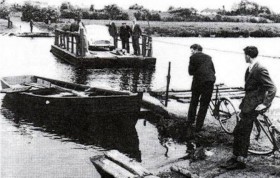Follow the brown signs



The Brown Sign Torch Relay Day 20: Irish ribs and torpedo testing stations
We’re on day 20 of my alternative torch relay already! We might be getting somewhat tired running around with our metaphorical torches but heavens above haven’t we happened upon some great places by veering off the route to follow the brown signs?! Yes we jolly well have (caught the brown-signing bug yet? I very much hope so).
Yet again I can’t include a picture of my Olympic torch relay map (I left it at home, God I miss it bad) but I can tell you that today the torch is back on British soil and heading from Newcastle (the Northern Irish one) over the Irish sea to Stranraer on the bonnie West coast of Scotland (one of my favourite places on the planet, sea eagles live there for the love of God, does it get much better than that?), but more on that tomorrow.
 The interactive London 2012 map told me that the torch would be crossing the large lake that sits in the middle of Northern Ireland in a “rib” this morning. Now, when I read things and I don’t know what they are I’m compelled to find out more about them and I have to admit to knowing very little about this lake and “ribs”, so I did some research.
The interactive London 2012 map told me that the torch would be crossing the large lake that sits in the middle of Northern Ireland in a “rib” this morning. Now, when I read things and I don’t know what they are I’m compelled to find out more about them and I have to admit to knowing very little about this lake and “ribs”, so I did some research.
The lake, Lough Neagh, covers 151 square miles and is the biggest freshwater lake in Britain. Legend has it that the lake was formed when an angry giant Fionn mac Cumhaill took a handful of land to throw across the sea at his Scottish rival, unfortunately though he missed and instead of taking out his nemesis the chunk of earth landed in the sea, which is how the Isle of Man came to be.
A rib is a traditionally made boat that has been around for centuries and are made of pieces of U-shaped wood (the “ribs”) that makeup the main frame which are covered with animal skin (although nor more commonly canvas), then painted with tar or another waterproof substance then paddled out on the water. It might sound like an unsophisticated mode of transport for our Olympic torch but these little boats have been plying this body of water and used by fishermen, tradesmen and people needing to cross the lake for centuries. They are a traditional and important part of this lakes history and there are some very interesting projects happening on these shores that are keeping traditional characteristics of the area, like rib boats, alive around Lough Neagh.
One of these organisations is Lough Neagh Heritage who are situated on Ballyronan Marina (which has a brown sign, win!) and exist to celebrate the heritage and history of this area. The lake has a rich history from the Mesolithic period right through to the preset day (Lough Neagh Eels have been caught for hundreds of years and are still prized for their taste, so much so that they have been given Protected Geographical Status under European Law). The lake stands in a strategic location between 6 counties and was first crossed by ferry services in the 1750s, since then the potential for transporting people and goods was recognised and 4 canals were built to connect the surrounding counties. Despite it’s potential though 3 of the 4 were eventually abandoned when the output from the coal mines in the late 1800s simply didn’t meet expectations and now only the Lower Bann waterway remains open (although there are some exciting plans to restore the Ulster Canal).
The lake also played it’s role in WWII when 5 airfields were built around it as it made a great place to practice bombing. Another reason was to protect shipping in the North Atlantic which came under threat from U-boat attacks. Shipping between Britain and America traditionally followed the route around the southern coast of Ireland, becoming vulnerable to attacks from the newly captured ports and airfields of northwest France. In order to protect trade the shipping route was diverted around the north coast of Ireland with the convoys being escorted by both the Navy and RAF. The importance of this trade was reflected in the increased numbers of Navy and RAF personnel stationed in Northern Ireland during this time and resulted in the construction of new bases in which to house and train them. The picture attached is the torpedo testing station at Antrim which STILL THERE! Creepy and ace.
This brown signed marina also has nature trails and wooded walks, a 100 year old boat, The maid of Antrim to go sight seeing on, a bird hide for all you birds watchers out there with rich wetlands around the lake and the community hosts frequent events and festivals around the shores. Too much to get down and shout about, but I hope I’ve managed to whet your appetite for this place, it looks totally ace 🙂







